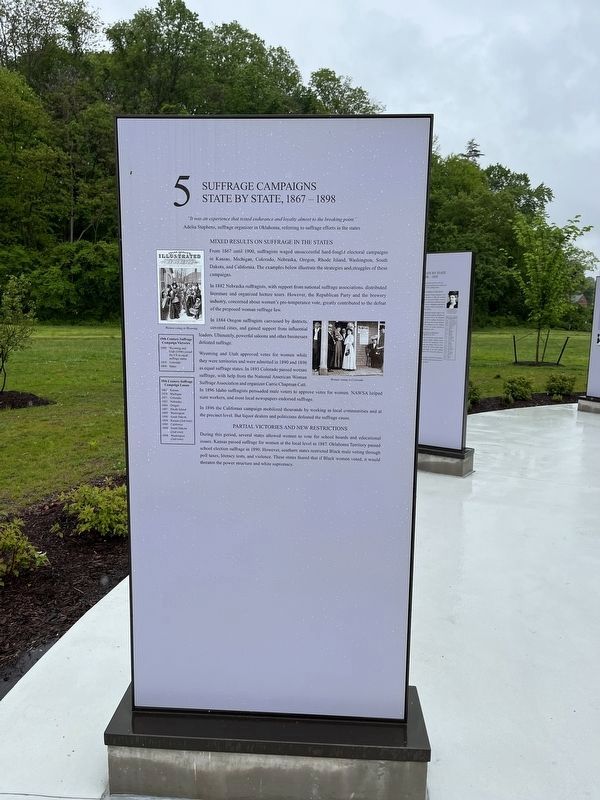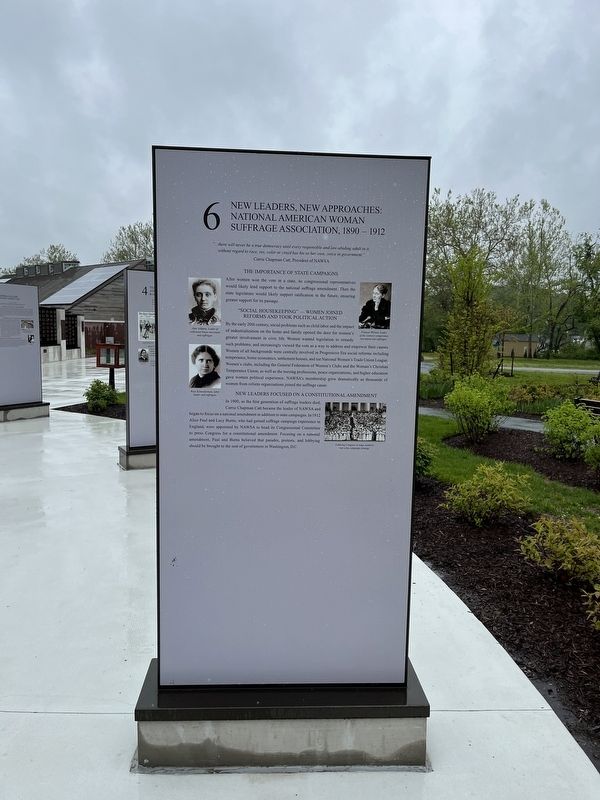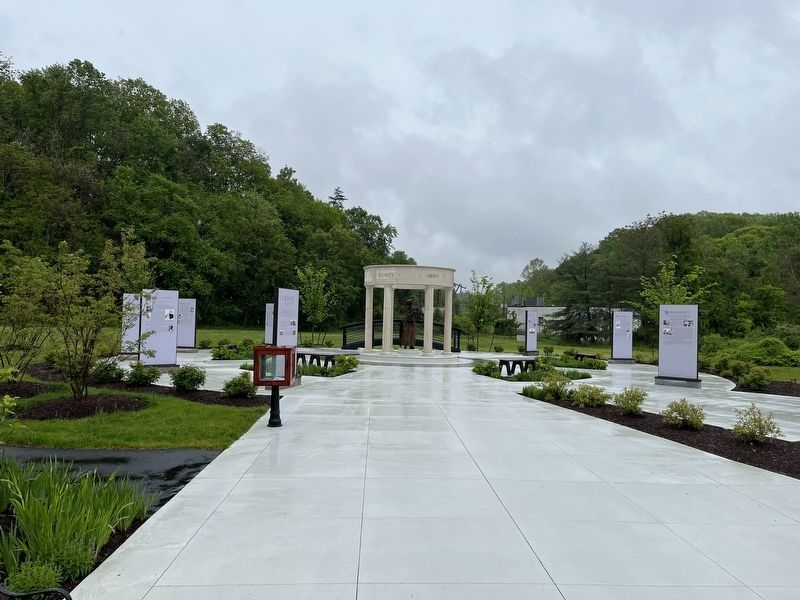Lorton in Fairfax County, Virginia — The American South (Mid-Atlantic)
Suffrage Campaigns State By State / New Leaders, New Approaches

Photographed By Devry Becker Jones (CC0), May 6, 2022
1. Suffrage Campaigns State By State side of the marker
Suffrage Campaigns State By State, 1867-1898
"It was an experience that tested endurance and loyalty almost to the breaking point."
Adelia Stephens, suffrage organizer in Oklahoma, referring to suffrage efforts in the states
Mixed Results on Suffrage in the States
From 1867 until 1900, suffragists waged unsuccessful hard-fought electoral campaigns in Kansas, Michigan, Colorado, Nebraska, Oregon, Rhode Island, Washington, South Dakota, and California. The examples below illustrate the strategies and struggles of these campaigns.
In 1882 Nebraska suffragists, with support from national suffrage associations, distributed literature and organized lecture tours. However, the Republican Party and the brewery industry, concerned about women's pro-temperance vote, greatly contributed to the defeat of the proposed woman suffrage law.
In 1884 Oregon suffragists canvassed by districts, covered cities, and gained support from influential leaders. Ultimately, powerful saloons and other businesses defeated suffrage.
Wyoming and Utah approved votes for women while they were territories and were admitted in 1890 and 1896 as equal suffrage states. In 1893 Colorado passed woman suffrage, with help from the National American Woman Suffrage Association and organizer Carrie Chapman Catt. In 1896 Idaho suffragists persuaded male voters to approve votes for women. NAWSA helped state workers, and most local newspapers endorsed suffrage.
In 1896 the California campaign mobilized thousands by working in local communities and at the precinct level. But liquor dealers and politicians defeated the suffrage cause.
Partial Victories and New Restrictions
During this period, several states allowed women to vote for school boards and educational issues. Kansas passed suffrage for women at the local level in 1887. Oklahoma Territory passed school election suffrage in 1890. However, southern states restricted Black male voting through poll taxes, literacy tests, and violence. These states feared that if Black women voted, it would threaten the power structure and white supremacy.
[Timelines:]
19th Century Suffrage Campaign Victories
1890: Wyoming and Utah (1896) joined the US as equal suffrage states.
1893: Colorado
1896: Idaho
19th Century Suffrage Campaign Losses
1867: Kansas
1874: Michigan
1877: Colorado
1882: Nebraska
1884: Oregon
1887: Rhode Island
1889: Washington
1890: South Dakota
1894: Kansas (2nd time)
1896:CaliforniaPhotographed By Devry Becker Jones (CC0), May 6, 20222. New Leaders, New Approaches side of the marker
1898: South Dakota (2nd time)
1898: Washington (2nd time)
New Leaders, New Approaches: National American Woman Suffrage Association, 1890-1912
"…there will never be a true democracy until every responsible and law-abiding adult in it, without regard to race, sex, color or creed has his or her own…voice in government."
Carrie Chapman Catt, President of NAWSA
The Importance of State Campaigns
After women won the vote in a state, its congressional representatives would likely lend support to the national suffrage amendment. Then the state legislature would likely support ratification in the future, ensuring greater support for its passage.
"Social Housekeeping" — Women Joined Reforms and Took Political Action
By the early 20th century, social problems such as child labor and the impact of industrialization on the home and family opened the door for women's greater involvement in civic life. Women wanted legislation to remedy such problems, and increasingly viewed the vote as a way to address and empower their causes. Women of all backgrounds were centrally involved in Progressive Era social reforms including temperance, home economics, settlement
New Leaders Focused on a Constitutional Amendment
In 1900, the first generation of suffrage leaders died, Carrie Chapman Catt became the leader of NAWSA and began to focus on a national amendment in addition to state campaigns. In 1912 Alice Paul and Lucy Burns, who had gained suffrage campaign experience in England, were appointed by NAWSA to head its Congressional Committee to press Congress for a constitutional amendment. Focusing on a national amendment, Paul and Burns believed that parades, protests, and lobbying should be brought to the seat of government in Washington, D.C.
[Captions:]
Jane Addams, leader of settlement house movement and suffragist.
Rose Schneiderman, labor leader and suffragist.
Frances Willard, leader of the women's temperance movement and suffragist.
Lobbying Congress in large numbers was a key campaign strategy.
Erected 2021 by Turning Point Suffragist Memorial Association. (Marker Number 5/6.)
Topics. This historical marker is listed in these topic lists: African Americans • Civil Rights • Government & Politics • Law Enforcement • Political Subdivisions • Women. A significant historical year for this entry is 1867.
Location. 38° 40.937′ N, 77° 15.177′ W. Marker is in Lorton, Virginia, in Fairfax County. Marker is on Lorton Road, one mile east of Ox Road (Virginia Route 123), on the left when traveling east. Touch for map. Marker is at or near this postal address: 9751 Ox Rd, Lorton VA 22079, United States of America. Touch for directions.
Other nearby markers. At least 8 other markers are within walking distance of this marker. Building a Political Movement / Testing Constitutional Amendments (here, next to this marker); New Life in State by State Campaigns / The 1913 Suffrage Parade Captured National Attention (here, next to this marker); "Forward Out of Darkness" / Issuing a Call for Women's Rights (a few steps from this marker); 1916 / Nonviolent Protests at the White House Gates (a few steps from this marker); Hard-Fought Ratification Campaigns in the States / The Continued Struggle for Voting Rights (a few steps from this marker); The Suffrage Campaign in Wartime / Suffrage Pickets Chose Prison (a few steps from this marker); Victories in 1917 / Suffragists Demonstrated Until Congress Passed the 19th Amendment (a few steps from this marker); Worsening Conditions / Violent Repression (a few steps from this marker). Touch for a list and map of all markers in Lorton.
Additional commentary.
1. About Jane Addams
Historians are in consensus in considering Jane Addams a lesbian in the modern construction of the term.
This information is included in commentary because LGBT individuals' full lives are often excluded from historical markers and are often "hidden histories." Sharing these details is intended to give a fuller context to their lives.
— Submitted May 7, 2022, by Devry Becker Jones of Washington, District of Columbia.
Additional keywords. Jim Crow era; racial terror lynchings; voter suppression; temperance; settlement house movement; LGBT; LGBTQ; 🏳️🌈
Credits. This page was last revised on November 6, 2023. It was originally submitted on May 7, 2022, by Devry Becker Jones of Washington, District of Columbia. This page has been viewed 98 times since then and 13 times this year. Photos: 1, 2. submitted on May 7, 2022, by Devry Becker Jones of Washington, District of Columbia. 3. submitted on May 6, 2022, by Devry Becker Jones of Washington, District of Columbia.

